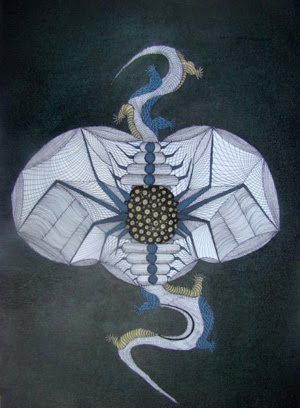skip to main |
skip to sidebar
Mayank Kumar Shyam is the son of the famous painter Jangarh Singh Shyam (1960-2001). Mayank exhibits for the first time in Kolkata at the age of 19. Born in 1987, Mayank is one of the few Gond artists to free himself from an inspiration exclusively linked to his roots. His art creates a bridge between tradition and innovation. His works on paper and canvas express a personal vision. The forms involve geometry. Many of his papers have insects as a topic. The spider is omnipresent in them. The symmetry of the body deploys its members in a perfect geometry. A mirror effect that we can find in Mayank’s drawings. The randomness disrupts graphically and poetically this apparent order. For example, the body of the spider sees itself being extended by a double lizard’s tail. One rising towards the top, the other, in a reversed effect, down, as are opposed the figures in card games. One thinks of the drawings of M. C. Escher, who, by a subtle play of contrary perspectives abysses the look (= mettre en abyme). The backgrounds, worked in “rotring”, are studded with etching and points. They evoke the air, the water, but also the unspeakable, the dream, the night…

Mayank Kuamr Shyam 2011 ink on paper 48x33 cm
Another recurring theme emerging in this work, is the one of the tree. Mayank associates the tree to the woman. His trees have breasts, sexes. A design of the female sex similar to the fork of two emerging branches. The Babian of India is a closely related species of fig tree. It can develop into a giant tree. Its roots soar through the air. They recurr in the drawings of Mayank. Their rounded ends have something sexual. Whether drops of milk or sperm, they remain suspended in space as are Ernesto Neto’s spiced burdened fabrics. Mayank's art is among the most promising and illustrates how, for these emerging artists from cultures so different from the prevailing ones, governing the world of contemporary art, the accomplice insight of our outsider’s looks is essential to support the completion of works like his, far from expectation, yet pervasive, as an exclusively folkloric demonstration.





